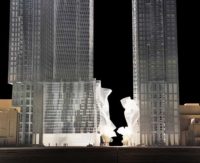After delays attributed to the global economic recession, construction has begun on two of Abu Dhabi’s five planned cultural buildings—the Louvre Abu Dhabi and the Guggenheim Abu Dhabi museums.
The five facilities will form an emerging cultural district on Saadiyat Island, located 500 meters from the city of Abu Dhabi, which serves as the capital of the United Arab Emirates. Officials at Abu Dhabi’s Tourism Development and Investment Co. (TDIC), which is developing the island, say they are using the recession to take advantage of reduced prices in construction materials and equipment.
TDIC officials decline to give a value on individual contracts or on the development as a whole, but media reports have estimated that the entire Saadiyat project—which includes nine five-star hotels, the Saadiyat Beach Golf Club and villas to house about 145,000 residents—would cost about $27 billion.
A galaxy of international “starchitects” has been commissioned for the cultural buildings, one more iconic-looking than the next. Ateliers Jean Nouvel, Paris, is designing the Louvre, which resembles a giant mushroom cap. Gehry Partners, Los Angeles, is the architect for the Guggenheim outpost, which features a mix of oversized and seemingly randomly placed geometric shapes. Foster + Partners, London, has the commission for the Zayed National Museum. The Zayed galleries will be housed in five soaring forms designed to resemble the feathers of a falcon—a favorite of the late Sheikh Zayed bin Sultan Al Nahyan, for whom the museum is named—but functioning as solar thermal towers. Zaha Hadid Architects, London, has conceived the Performing Arts Centre, the design of which evokes the lines and shape of a bicycle helmet. Tadao Ando Architect & Associates, Tokyo, has the commission for the Maritime Museum, which is designed to resemble a modernistic sail to symbolize the close relationship the U.A.E. has to the Persian Gulf.
According to the government agency’s website, the Zayed, Louvre and Guggenheim are scheduled to open in 2013. TDIC expects to announce a main contractor for the Louvre by April, based on bids received in November. Last fall, TDIC invited builders to bid on the concrete contract for the Guggenheim. The project includes excavation, filling, waterproofing and construction of nearly 120,000 cu m of reinforced-concrete slabs, retaining walls, columns and beams. A winner has not been announced.
For the Louvre’s foundation sitework, Bauer International FZE, the local arm of the German construction giant Bauer International GmbH, Schrobenhausen, “used an environmentally sustainable and economical mixed-in-place, sand-cement wall that acted as a diaphragm wall to facilitate excavation and dewatering,” says Stuart Magee, a TDIC executive director. “This was the first time this technique was utilized in the U.A.E. and, as far as we’re aware, in the Middle East,” he adds.
Workers have finished installing the Louvre’s 3,600 large-diameter bored piles. Because the basement floor has only a few expansion joints to ensure maximum waterproofing, the bored piles include high-strength, H-section steel columns to resist slab shrinkage, says Magee.
Foundations for the Guggenheim include a two-kilometer-long structural sea wall, completed in June, that defines the museum’s footprint. The local Al Habtoor and its Al Habtoor-STFA Soil Group LLC expect to complete the building’s 1,700 piles by March.






